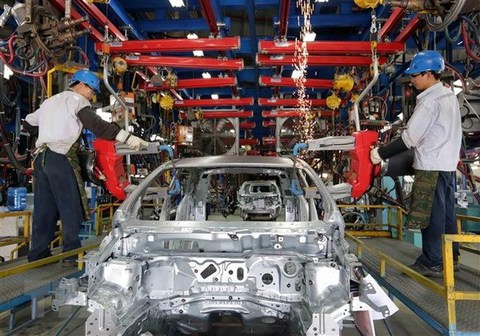
Workers produce cars at the Ford factory in the northern province of Hai Duong. Viet Nam's gross domestic product (GDP) growth is set at 6.8 per cent for 2019-20, driven by a stronger private sector, improved policies and benefit from the global trade tensions.— VNA/VNS Photo Tran Viet
The Ministry of Planning and Investment (MPI) will continue working hard to ensure gross domestic product (GDP) growth reaches 6.8 per cent at the end of the year.
The target is lower than the actual number of 7.08 per cent recorded in 2018.
The ministry will work with other ministries, government agencies and local authorities to keep inflation below 4 per cent this year.
It will also keep a close watch over regional and international economic developments while working with the ministries of Finance and Industry and Trade and the State Bank of Viet Nam to predict possible outcomes of developments.
The MPI will also improve existing regulations and offer solutions to enhance law enforcement among government agencies.
At the next meeting of the 14th National Assembly in November, the ministry will deliver the draft laws on investment, enterprises and public-private-partnership (PPP) model for discussion.
A plan to raise capital for the development of the water and land transport systems will be developed so the systems are connected to the Viet Nam-Cambodia border gates.
In addition, solutions to lure more foreign direct investment (FDI) will also be examined.
US tariff: not yet
There is little chance the US will slap tariffs on Vietnamese exports, Luong Van Khoi, deputy director of the National Centre for Socio-Economic Information and Forecast (NCIF), told the MPI meeting on Thursday.
If the US wants to add tariffs, it must find out if that economy has achieved a trade surplus worth more than US$20 billion in two-way trade with the US.
In addition, that economy must have a surplus balance that exceeds 2 per cent of the country’s GDP and continuously ensure the monetary market keeps currency weaker than the US dollar to make exports competitive.
Viet Nam has not committed any action regarding monetary intervention, so the US will not slap tariff on Vietnamese exports, Khoi said.
In the short term, Viet Nam may benefit from the US-China trade war as investors may move their production to other markets that are not influenced by the tariff, including Viet Nam, he said.
But in the long term there will be problems as technology and supply chains are key matters where Viet Nam is still weak at, he added.
To deal with the impact of the US-China trade war, Khoi recommended Government continue stabilising the macro-economic conditions and take control of the dong to deal with a weaker Chinese yuan.
“We need to increase trade protectionism measures to prevent Chinese goods from flooding the domestic market. In the meantime, we need to monitor Chinese capital closely, especially companies that want to assemble products in Viet Nam and export them to the US market.”
According to the Department of Foreign Investment, total value of FDI from Asian in the first five months rose 86 per cent.
Among those countries, China was the third largest investor with total investment of $2.2 billion recorded in the five-month period.
GDP is 6.8% in 2020
Prime Minister Nguyen Xuan Phuc has issued a socio-economic development plan that targets the GDP growth rate at 6.8 per cent in 2020.
Under the plan, the macro-economic conditions must be strengthened, inflation must be controlled and the internal strength of the economy must be increased.
Existing policies should be fixed and improved so the business and investment environment improves for private companies. — VNS